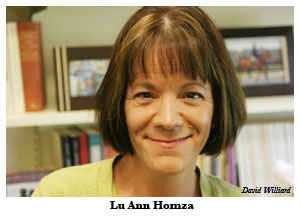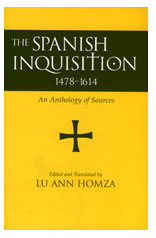The Inquisition: Is it relevant to Guantanamo?
 Lu Ann Homza knows that readers of her recent book The Spanish Inquisition: 1478-1614
will perceive parallels to the alleged treatment of detainees at
Guantanamo Bay that have been reported in the nation's popular media.
On the surface, the use of torture to obtain confessions is common to
each. Yet, Homza, the Class of 2006 Associate Professor of History at
the College, resists drawing direct comparisons.
Lu Ann Homza knows that readers of her recent book The Spanish Inquisition: 1478-1614
will perceive parallels to the alleged treatment of detainees at
Guantanamo Bay that have been reported in the nation's popular media.
On the surface, the use of torture to obtain confessions is common to
each. Yet, Homza, the Class of 2006 Associate Professor of History at
the College, resists drawing direct comparisons.“The Spanish Inquisition can serve as a powerful example of suffering when authority figures decide to prosecute people for beliefs,” Homza said. “That being said, I wouldn’t want to make a direct parallel between the Spanish Inquisition and Guantanamo Bay because that would only continue the mythology of the Spanish Black Legend—that the Spanish are somehow intrinsically barbaric, intrinsically regressive, intrinsically persecutory.”
Homza is not an apologist for the Spanish Inquisition. “It was a wicked institution; a terrible phenomenon,” she said. During its three-and-a-half-century existence, the Inquisition targeted Christians as heretics who endorsed Jewish, Muslim and Protestant teachings and pressured them toward reconciliation with the Roman Catholic Church. In the process, multitudes were dispossessed. Thousands were burned at the stake.
“I would say if people are shocked by what is going on in Guantanamo, and they want to look for examples of persecution that was state-sponsored in the past, looking at the Spanish Inquisition is a good place to start,” Homza said. However, she urges intellectual caution. “Although much of the Spanish Inquisition looks relevant to Guantanamo, we risk losing depth and nuance by drawing such parallels,” she said.
 Homza published her book in an attempt to
help undergraduates study the Spanish Inquisition, not to weigh in on
contemporary moral debates. The book comprises a collection of source
materials she has translated into English; the materials include
records of actual tribunal proceedings along with policy papers
detailing such things as an inquisitor’s role and the relationship
between tribunals and the cities in which they are established. As one
reads the documents, one can visualize the birth of a self-sustaining
bureaucracy. At times, it can be viciously cruel; at other times, it
seems ploddingly ineffective.
Homza published her book in an attempt to
help undergraduates study the Spanish Inquisition, not to weigh in on
contemporary moral debates. The book comprises a collection of source
materials she has translated into English; the materials include
records of actual tribunal proceedings along with policy papers
detailing such things as an inquisitor’s role and the relationship
between tribunals and the cities in which they are established. As one
reads the documents, one can visualize the birth of a self-sustaining
bureaucracy. At times, it can be viciously cruel; at other times, it
seems ploddingly ineffective.“What I like about teaching the inquisition is that students come in expecting to encounter a monolithic institution that looks like a machine—it looks as if it walks around chewing up people and spitting them out,” Homza said. “Yet, what we find in the records is that it was chaotic, messy and exorable.”
Founded in 1478 by King Ferdinand of Aragon and Queen Isabella of Castille, the Inquisition was intended to bring back into the Christian fold converts from Judaism who were continuing to practice Jewish rituals, Homza explained. At first these conversos, as they were called, tended to be well-placed in society; later most of the victims were poor. Between 1540 and 1580, inquisitors focused on people considered “Old Christians,” those who lacked Jewish ancestry. During these trials, charges of sodomy, bigamy and blasphemy often were presented. Later, in 1568, when King Philip II faced revolt of the Moriscos during his war with the Ottoman Empire, the Inquisition turned its teeth toward those in Spain who adhered to Islamic practices.
The Inquisition was known for its use of torture. Three methods were employed, according to Homza. One involved putting a person on his back, tying him down, putting a gauze over his face and pouring pitchers of water over his mouth and nostrils in order to simulate drowning. Another method consisted of tightening cords around various parts of the bodies. A third method consisted of tying a person’s hands behind his back and hoisting him by the wrists. Victims were tortured in a state of half-dress, a tactic designed to “humiliate and terrify,” Homza said.
“For the inquisitors, torture was done purely for the sake of confession,” Homza explained. “It was interrogatory as opposed to punitive, and it was done by professionals.” Even though confessions were considered the highest proof of the heresy, safeguards were in place, she said. Inquisitors knew that confessions made under torture were problematic, so they would have to go back to the victim and have the confession reaffirmed after a period of time.
During the Inquisition, such trials were, in theory, secret affairs. The practice, ostensibly, was to protect those making charges from retaliatory vengeance by family members of the accused.
“One of the real horrors of an inquisition trial arose when you were arrested and had no idea why,” Homza said. Prisoners were never told the identity of witnesses against them. Consequently, they had to guess who their accusers were in order to challenge their credibility. Trials could end when defendants were able to prove that the charges against them were born of malice. “What is really painful to see in these trials is when the accused get it wrong,” Homza said. “One victim, Marina Gonzales, from 1494, never guesses that one of the chief witnesses against her is the very man she has called as a character witness. Those kinds of accidents happen. That’s a horror for the defendant.”
Homza’s favorite documents in the book involve individuals who circumscribed the harsh order the inquisitors sought to impose. One widely used tactic was employed when defendants refused to cooperate. They did not call witnesses, they did not attempt to recuse their accusers, they simply wrote appeal after appeal, in effect overburdening the tribunal with paperwork. After a period of time, these cases often were dismissed.
“Other rules were overturned all the time,” Homza said. “We have prisoners who escaped by bribing guards. Occasionally, prisoners became friends with the prison staff and held parties in the tribunal itself. Defendants often smuggled documents in and out of the building where they were being held in order to obtain the identities of those testifying against them. My favorite incident occurred in 1534 in Toledo, when a prisoner was put in a cell on the second floor and just took advantage of his location by opening the window, leaning out and talking with everybody on the street below.”
There remains much about the Spanish Inquisition that historians will continue to research and to debate. Whether the actual intent was religiously or racially motivated is a question that continues to be argued—Homza believes it was a mixture. Just how pervasive the Inquisition was also continues to be questioned—Homza suggested that in some parts of Spain citizens could have lived their entire lives without awareness of the institution. Historians also will find heroes, those who tried to clean up the institution from within, and villains, those who bent the rules for personal pleasure and gain.
As the research proceeds, Homza knows that many people will react negatively. “It makes people remarkably uncomfortable even for the subject to be studied, and even more so when we end up concluding, after many years of research, that the Inquisition was more complex and ambiguous, and maybe even more benign, than we ever expected,” she said. She also knows that students of the Spanish Inquisition will be alert to patterns that seem to repeat themselves in contemporary societies.
Although publishing her book had nothing to do with 9/11 or with the subsequent detainment and questioning of people suspected of connections to terrorist plots or organizations by U.S. officials—“it was purely serendipitous that the book arrived at this point in time,” she said—now that it is out, she believes it perhaps can cast some light on the current situation.
“Maybe the broader lesson is that when a state sponsors and promotes an institution that is devoted to persecuting people for their beliefs, society ends up in a perilous situation, because the state has legitimized the persecution of deviance,” Homza said. “Deviance itself is subject to interpretation, and the individuals pursuing the allegedly deviant may be more or less honorable and intelligent.”
Homza suggests that a number of historians have discussed whether or not the Inquisition may have been ahead of its time. “Was it perhaps a modern institution in an embryonic way?” she asked. “It’s hard not to be impressed with its bureaucracy and its legal depth, and when it functioned perfectly, its ability to attract people was breathtaking.”
 Skip to main content
Skip to main content
